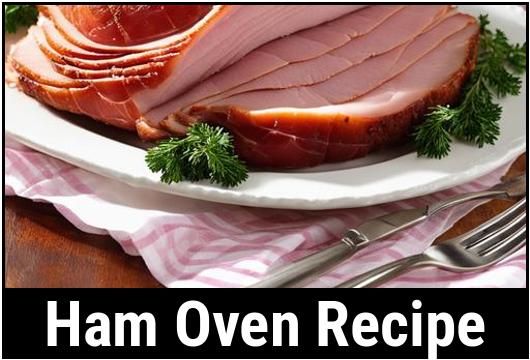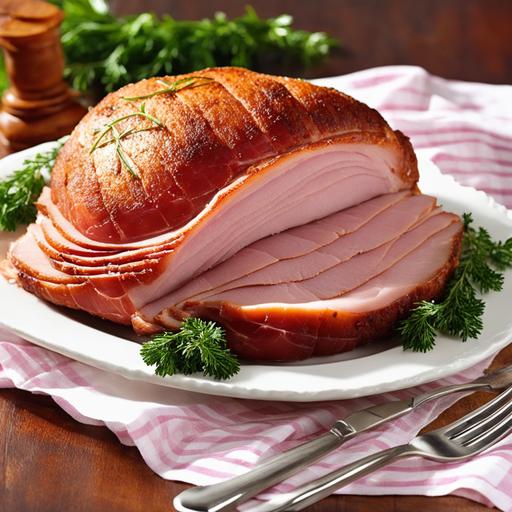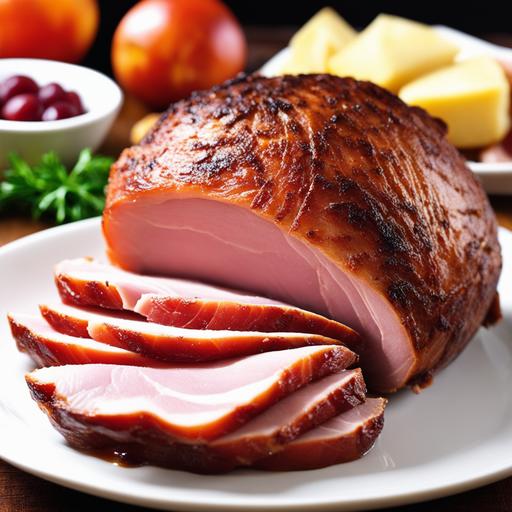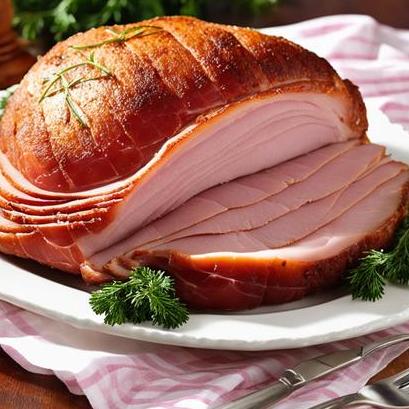
The Ultimate Guide To Cooking Ham In The Oven
When it comes to celebratory meals and festive gatherings, few dishes can surpass the inviting aroma and mouthwatering taste of a perfectly cooked ham. Whether you’re preparing a ham for a holiday feast or simply indulging in a scrumptious meal with loved ones, mastering the art of cooking ham in the oven is an essential culinary skill. In this comprehensive guide, we’ll delve into the fascinating food science behind ham, explore culinary details, share tips for selection, cleaning, and preparation, provide in-depth insight into doneness checks, offer a delectable recipe, and even touch upon the infamous pitfalls of overcooking and undercooking this delectable centerpiece.
The Science Behind Ham
Ham, derived from the hind leg of a pig, is a versatile and flavorful cut of meat that is often enjoyed in both cured and uncured forms. Understanding the science behind ham can elevate your cooking prowess and allow you to harness its full potential.
Curing and Flavor Enhancement
Cured ham undergoes a meticulous process of preservation that involves salting, brining, or smoking. During this curing process, various flavorings, such as spices, sweeteners, and even fruit juices, can be added to impart distinctive tastes. These flavor-enhancing agents work in harmony with the natural flavors of the meat, resulting in a balanced and appetizing final product.
Moisture Retention
Ham possesses a unique ability to retain moisture, making it difficult to overcook and ensuring a succulent texture. This characteristic is attributed to the presence of collagen, a protein found in connective tissues. When exposed to heat for an extended period, collagen gradually breaks down into a gelatin-like substance, creating a lusciously tender ham.
Culinary Considerations for Selecting Ham
Before embarking on your ham-cooking adventure, selecting the right ham is paramount. Here are some key factors to consider:
Cured or Uncured
Deciding between cured and uncured ham largely depends on personal preference. Cured ham tends to be more flavorful, often featuring a distinct smoky or salted taste. On the other hand, uncured ham possesses a milder flavor, making it an excellent choice for those who prefer a clean and natural taste. Both options can be readily cooked in the oven, offering an array of delicious possibilities.
Bone-In or Boneless
Ham can be purchased bone-in or boneless, each offering unique advantages. A bone-in ham enhances flavor since the bone imparts richness during the cooking process, while boneless ham provides ease when it comes to carving and serving.
Weight Considerations
When selecting the size of your ham, it’s essential to factor in the number of guests you’ll be serving. As a general rule of thumb, calculate approximately ½ to ¾ pounds per person, accounting for leftovers and the occasional second helping. Additionally, consider accommodating for the overall dimensions of your oven and cooking vessel.
Cleaning and Preparation Tips

Before diving into the cooking process, let’s cover essential cleaning and preparation steps:
Cleaning the Ham
When purchasing ham, always ensure it is fresh, free from any foul odors, and adequately wrapped. It’s advisable to remove any plastic or netting, and if applicable, rinse the ham under cold water to remove excess surface salt or brine. Patting it dry with paper towels will help create a favorable environment for browning during the cooking process.
Preparing the Ham
To further elevate the flavor profile, scoring the ham is an excellent technique. Taking a sharp knife, gently create a crisscross pattern on the fatty side of the ham. This scoring helps render the fat, promoting caramelization and intensifying the aromatic glory.
The Art of Cooking Ham

Now that your ham is clean, prepped, and ready for culinary perfection, let’s delve into some of the most critical aspects of the cooking process.
Temperature and Timing
Set your oven to a moderate temperature of around 325°F (163°C) for optimal results. Cooking time is typically calculated based on weight, allowing for approximately 15-20 minutes per pound of ham. However, it’s always advisable to consult the packaging or your butcher for specific instructions, as cooking time can vary depending on the type of ham.
Doneness Checks
Though timing is crucial, relying on temperature checks is the most accurate method for determining the doneness of your ham. Inserting a meat thermometer into the thickest part, making sure it doesn’t touch the bone, will provide an instant reading. Aim for an internal temperature of 145°F (63°C) for a ham that is safe to consume while still succulent and delicious.
A Classic Oven-Baked Ham Recipe

Now that we’ve covered the essential knowledge, let’s dive into a delightful recipe that is sure to impress your guests:
Classic Honey-Glazed Ham
Ingredients:
- 1 fully cooked bone-in ham (8-10 pounds)
- 1 cup of brown sugar
- ¼ cup of Dijon mustard
- ¼ cup of honey
- 2 tablespoons of apple cider vinegar
- ½ teaspoon of ground cloves
Instructions:
- Preheat your oven to 325°F (163°C).
- In a small saucepan over medium heat, combine the brown sugar, Dijon mustard, honey, apple cider vinegar, and ground cloves. Stir until the ingredients are well incorporated and the mixture has slightly thickened.
- Place the ham in a shallow roasting pan, fatty side up. Brush the honey glaze generously over the entire surface of the ham, reserving some glaze for basting throughout the cooking process.
- Cover the ham with aluminum foil, ensuring it is tightly sealed to retain moisture.
- Bake the ham in the preheated oven for approximately 15 minutes per pound, or until the desired internal temperature of 145°F (63°C) is reached.
- Every 30 minutes, carefully remove the foil and baste the ham with the remaining glaze, allowing the flavors to penetrate the meat deeply.
- Once cooked to perfection, remove the ham from the oven and let it rest for 15-20 minutes before carving.
- Serve your succulent honey-glazed ham with your favorite accompaniments and enjoy a delightful feast with your loved ones.
Pitfalls to Avoid: Overcooking and Undercooking
While cooking ham is a delightful endeavor, it’s crucial to avoid the pitfalls of overcooking or undercooking, which can compromise the texture and flavor of your dish.
Overcooking
Overcooking ham can result in dryness and toughness, robbing the meat of its desirable tenderness. Pay strict attention to cooking times and make use of a meat thermometer to prevent exceeding the recommended internal temperature of 145°F (63°C), thus ensuring a moist and enjoyable ham for your guests.
Undercooking
Serving undercooked ham can pose a risk to your health since it is pork. Always prioritize food safety and meticulously follow cooking time guidelines and temperature checks to guarantee that your ham is cooked to perfection without compromising its succulent appeal.
In conclusion, cooking ham in the oven is a culinary journey that combines art and science, resulting in a delectable centerpiece that is sure to delight any gathering. From understanding the food science behind ham to the nuances of selecting, cleaning, and preparing it, this guide has equipped you with all the knowledge needed to embark on your ham-cooking adventure. Remember to use your culinary prowess and infuse your personal touch to create a masterpiece that will leave your guests craving for more. Enjoy the process, savor the flavors, and relish the joy of mastering the art of cooking ham in the oven.
Sources
FAQS On Ham Oven Recipe
What Is A Good Ham Oven Recipe For A Family Dinner?
One delicious and easy ham oven recipe is a classic honey glazed ham. Start by preheating your oven to 325°F. Place the ham in a roasting pan and score the surface in a diamond pattern. Then, brush the ham with a mixture of honey, brown sugar, and Dijon mustard. Cover the ham with foil and bake for 1 hour. Uncover the ham and continue to bake for another 30-45 minutes, basting occasionally until the glaze is caramelized and the ham is heated through.
How Long Does It Take To Cook A Ham In The Oven?
The cooking time for a ham in the oven largely depends on its weight. As a general guideline, allow for 15-20 minutes of cooking time per pound of ham. For example, a 10-pound ham would take approximately 2.5-3.5 hours to cook in the oven at 325°F.
Can I Cook A Ham In The Oven Without A Roasting Pan?
If you don’t have a roasting pan, you can use a deep baking dish or even a disposable aluminum pan to cook a ham in the oven. Just make sure the pan is large enough to hold the ham comfortably and has high sides to catch any drippings. You can also line the pan with aluminum foil for easy cleanup.
What Are Some Delicious Seasoning Options For A Ham Oven Recipe?
There are many different seasonings and flavorings you can use to enhance the taste of a ham in the oven. Some popular options include a honey glaze (made with honey, brown sugar, and mustard), a pineapple glaze (made with pineapple juice, brown sugar, and cloves), or a mustard and herb crust (made with Dijon mustard, garlic, and herbs like thyme and rosemary).
How Do I Know When The Ham Is Done Cooking In The Oven?
The best way to determine if a ham is fully cooked is by using a meat thermometer. Insert the thermometer into the thickest part of the ham, making sure not to touch the bone. The internal temperature should reach 140°F for a fully cooked ham. Once the ham reaches the desired temperature, remove it from the oven and let it rest for 15-20 minutes before slicing and serving.



